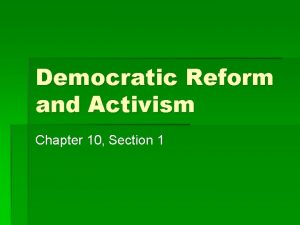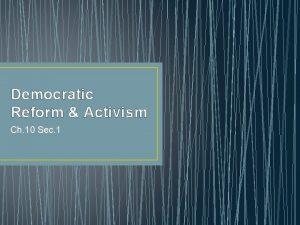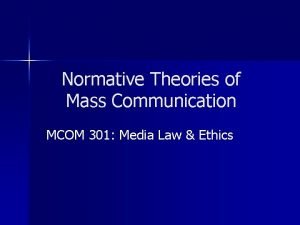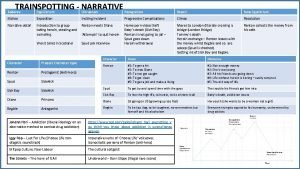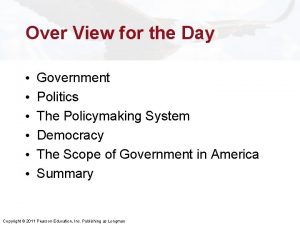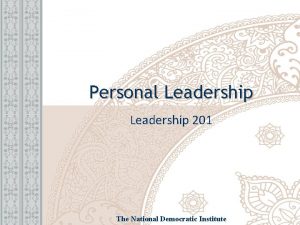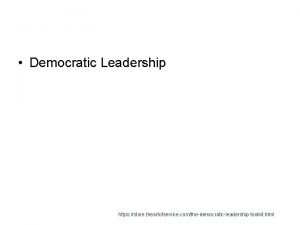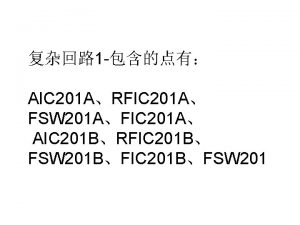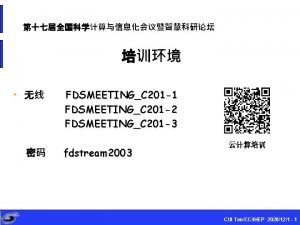Personal Leadership 201 The National Democratic Institute INTRODUCTIONS



























- Slides: 27

Personal Leadership 201 The National Democratic Institute

INTRODUCTIONS/ GROUND RULES • Introductions • Ground rules • Ice breaker exercise

OBJECTIVES Ø Develop tools for personal leadership Ø Learn strategies for effective personal leadership Ø Learn the difference between assertiveness and aggressiveness

TOPICS • Work/Life Balance and Emotional Support • Developing a Personal Code of Conduct and Mission Statement • Assertiveness Skills • Handling Personal Attacks/Criticism • Dealing with Sexual Harassment

KEY TERMS • Leadership • Personal Leadership

LIVING A BALANCED LIFE • Looking at the Big Picture – How confident are you? – How happy are you? – How authentic and honest are you with yourself?

LIVING A BALANCED LIFE • Assessing your current balance – Education – Community Engagement – Networking – Visibility – Finances – Health – Personal – Family and Relationships – Spiritual – Love

EXERCISE: LIVING A BALANCED LIFE • Total your score – Your score/65 total points • There is no “perfect” or “failing” score!

SUPPORTING YOURSELF EMOTIONALLY • Take care of yourself • Cultivate your support network • Acknowledge and deal with your emotions when they arise • Focus on what you can control Emotional Self-Care Includes: ü Healthy Choices ü Establishing Boundaries ü Work/Life Balance

SUPPORTING YOURSELF EMOTIONALLY • Focus on what you can control What we cannot control Our thoughts Other people’s thoughts Our choices Other people’s choices Our actions Other people’s actions Everything else!

TIME MANAGEMENT

OBSTACLES TO EFFECTIVE TIME MANAGEMENT • Technical Errors • External Realities • Personal Habits and Perceptions of Time

WHERE DOES OUR TIME GO?

3 STEPS TO MANAGING TIME 1. Develop life goals 2. Select activities to achieve your goals 3. Choose daily tasks that make up these activities and make time for them

PERSONAL CODE OF CONDUCT Ø What is a code of conduct? • Set of rules/guidelines • Reflects values • Guides behavior

EXERCISE: PERSONAL CODE OF CONDUCT Principles Values Practices

MISSION STATEMENTS Ø What is a mission statement? – A mission statement defines: • What you will do • Why • For Whom Mission Statements Should: ü Be Concise ü Reflect Your Purpose ü Be a Decision-Making Tool

MISSION STATEMENTS

MISSION STATEMENT EXAMPLE “I will promote the primary prevention of sexual and domestic violence through education, collaboration and action for all people in my community. ” “My mission is to empower individuals across the globe in living balanced, fulfilling, physically and spiritually healthy lives. I myself live my life as an example of these principles. Through compassion, respect, dedication and consideration I pledge to demonstrate my love for and to support my amazing family and the community at large as my life brings meaningful and powerful change on the small and large scale. ”

EXERCISE: MISSION STATEMENT • • My purpose is to do what (action)… For whom (who do you serve)… So that (result of our action)… What would you like to BE, DO, and HAVE? Brainstorm what is MOST important to you.

ASSERTIVENESS • Communication strategy Ø Acting in your own best interest Ø Standing up for legitimate rights Ø Expressing views directly/openly Assertiveness is NOT the same thing as aggressiveness.

EXERCISE: ASSERTIVENESS ROLE PLAYS Photo: NDI

HANDLING PERSONAL ATTACKS • Recognize personal attacks • Stay calm under pressure • Develop an appropriate viewpoint • Admit when you made a mistake • Tell the person to stop • Organize allies to support you

DEALING WITH SEXUAL HARASSMENT

DEALING WITH SEXUAL HARASSMENT What can you do? Ø Do not feel obliged to listen to these comments or act on your harasser's suggestions Ø Report this person to someone you trust Ø Work together with other women on a "no tolerance" policy Ø Bring it to the media

DEALING WITH SEXUAL HARASSMENT EXAMPLE Photo: NDI

PERSONAL LEADERSHIP REVIEW • Work/Life Balance • Developing a Personal Code of Conduct and Mission Statement • Assertiveness Skills • Handling Personal Attacks/Criticism • Dealing with Sexual Harassment Ø Questions? Ø Feedback?
 Democratic leadership meaning
Democratic leadership meaning Asccc leadership institute
Asccc leadership institute Lejeune leadership institute
Lejeune leadership institute Teleos leadership
Teleos leadership Acs leadership
Acs leadership Va healthcare leadership talent institute
Va healthcare leadership talent institute Leadership institute texas state
Leadership institute texas state Democratic decentralized in software engineering
Democratic decentralized in software engineering 7 democratic ideals
7 democratic ideals Normative media theory
Normative media theory Federalist vs democratic republicans chart
Federalist vs democratic republicans chart Is elon musk a democratic leader
Is elon musk a democratic leader Chapter 10 section 1 democratic reform and activism
Chapter 10 section 1 democratic reform and activism Chapter 10 section 1 democratic reform and activism
Chapter 10 section 1 democratic reform and activism Democratic participant media theory
Democratic participant media theory Democratic peace theory
Democratic peace theory Democratic-republicans definition
Democratic-republicans definition Four theories of the press
Four theories of the press Democratic environmental caucus of florida
Democratic environmental caucus of florida Democratic republic of america
Democratic republic of america Canindates
Canindates Democratic party constitution
Democratic party constitution Trainspotting ideologies
Trainspotting ideologies Fundamental democratic rights
Fundamental democratic rights Democratic developments in england
Democratic developments in england Robert dahl's traditional democratic theory
Robert dahl's traditional democratic theory Whitman democratic vistas
Whitman democratic vistas Democratic developments in england
Democratic developments in england












